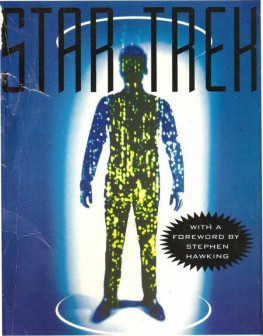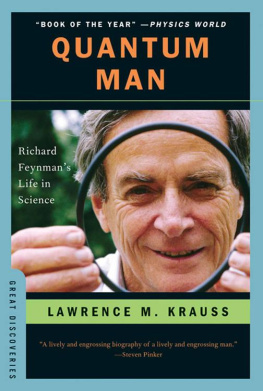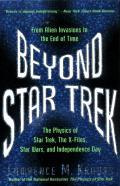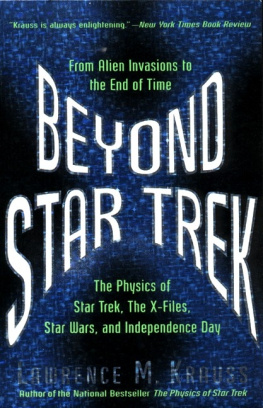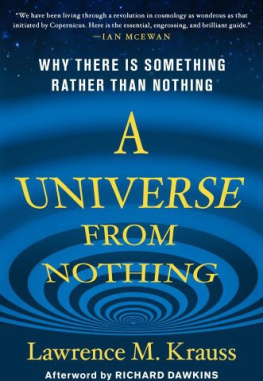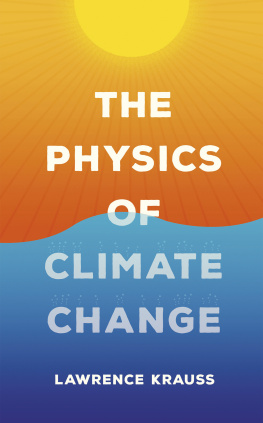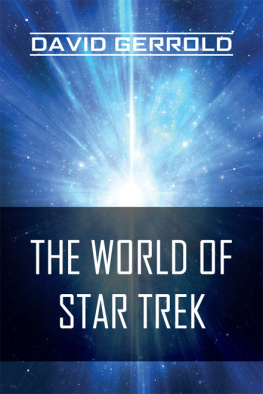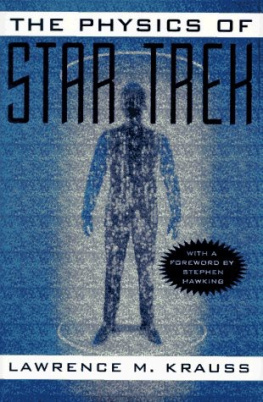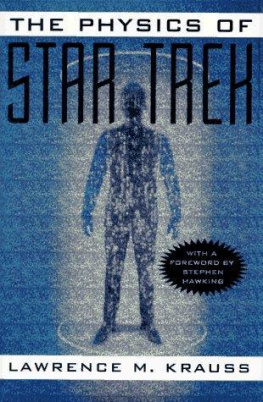Lawrence M. Krauss - The Physics of Star Trek
Here you can read online Lawrence M. Krauss - The Physics of Star Trek full text of the book (entire story) in english for free. Download pdf and epub, get meaning, cover and reviews about this ebook. year: 1997, publisher: Flamingo, genre: Science. Description of the work, (preface) as well as reviews are available. Best literature library LitArk.com created for fans of good reading and offers a wide selection of genres:
Romance novel
Science fiction
Adventure
Detective
Science
History
Home and family
Prose
Art
Politics
Computer
Non-fiction
Religion
Business
Children
Humor
Choose a favorite category and find really read worthwhile books. Enjoy immersion in the world of imagination, feel the emotions of the characters or learn something new for yourself, make an fascinating discovery.
- Book:The Physics of Star Trek
- Author:
- Publisher:Flamingo
- Genre:
- Year:1997
- Rating:4 / 5
- Favourites:Add to favourites
- Your mark:
- 80
- 1
- 2
- 3
- 4
- 5
The Physics of Star Trek: summary, description and annotation
We offer to read an annotation, description, summary or preface (depends on what the author of the book "The Physics of Star Trek" wrote himself). If you haven't found the necessary information about the book — write in the comments, we will try to find it.
The Physics of Star Trek — read online for free the complete book (whole text) full work
Below is the text of the book, divided by pages. System saving the place of the last page read, allows you to conveniently read the book "The Physics of Star Trek" online for free, without having to search again every time where you left off. Put a bookmark, and you can go to the page where you finished reading at any time.
Font size:
Interval:
Bookmark:
THE PHYSICS OFSTAR TREK
LAWRENCE M.KRAUSS
W I T H A F O R E W O R D B Y
S T E P H E N H A W K I N G
Flamingo
An Imprint ofHarperCollinsPublishers
77-85 Fulham PalaceRoad Hammersmith, London, W6 8JB
Published byFlamingo 1997
9 8 7 6 5 4 3 2 1
First published inthe UK by HarperCollinsPublishers, 1996
First published inthe USA by Basic Books, a division of HarperCollinsPublishers,1995
Copyright LawrenceKrauss, 1995
Lawrence Krauss hasasserted the moral right to be identified as the author of thiswork
A catalogue entryfor this book is available from the British Library
ISBN 0 583 51149X
Set in Sabon
Printed and bound inGreat Britain by
CaledonianInternational Book Manufacturing Ltd, Glasgow All Rights reserved.No part of this publication may be reproduced, stored in aretrieval system, or transmitted, in any form or by any means,electronic, mechanical, photocopying, recording or otherwise,without the prior permission of the publishers.This book issold subject to the condition that it shall not, by way of trade orotherwise, be lent, re-sold, hired out or otherwise circulatedwithout the publisher's prior consent in any form of binding orcover other than that in which it is published and without asimilar condition including this condition being imposed on thesubsequent purchaser.
Stephen Hawking
I was very pleased that Data decided to callNewton, Einstein, and me for a game of poker aboard the Enterprise. Here was my chance to turn the tables onthe two great men of gravity, particularly Einstein, who didn'tbelieve in chance or in God playing dice. Unfortunately, I nevercolected my winnings because the game had to be abandoned onaccount of a red alert. I contacted Paramount studios afterward tocash in my chips, but they didn't know the exchange rate.
Science fiction like Star Trek is not only goodfun but it also serves a serious purpose, that of expanding thehuman imagination. We may not yet be able to boldly go where no man(or woman) has gone before, but at least we can do it in the mind.We can explore how the human spirit might respond to futuredevelopments in science and we can speculate on what thosedevelopments might be. There is a two-way trade between sciencefiction and science. Science fiction suggests ideas that scientistsincorporate into their theories, but sometimes science turns upnotions that are stranger than any science fiction. Black holes arean example, greatly assisted by the inspired name that thephysicist John Archibald Wheeler gave them. Had they continued withtheir original names of "frozen stars" or "gravitationallycompletely collapsed objects," there wouldn't have been half somuch written about them.
One thing that StarTrek and other science fiction have focused attention on is travelfaster than light. Indeed, it is absolutely essential to StarTrek's story line. If the Enterprise wererestricted to flying just under the speed of light, it might seemto the crew that the round trip to the center of the galaxy tookonly a few years, but 80,000 years would have elapsed on Earthbefore the spaceship's return. So much for going back to see yourfamily!
Fortunately,Einstein's general theory of relativity allows the possibility fora way around this difficulty: one might be able to warp spacetimeand create a shortcut between the places one wanted to visit.Although there are problems of negative energy, it seems that suchwarping might be within our capabilities in the future. There hasnot been much serious scientific research along these lines,however, partly, I think, because it sounds too much like sciencefiction. One of the consequences of rapid interstellar travel wouldbe that one could also travel back in time. Imagine the outcryabout the waste of taxpayers' money if it were known that theNational Science Foundation were supporting research on timetravel. For this reason, scientists working in this field have todisguise their real interest by using technical terms like "closedtimelike curves" that are code for time travel. Nevertheless,today's science fiction is often tomorrow's science fact. Thephysics that underlies Star Trek is surely worth investigating. Toconfine our attention to terrestrial matters would be to limit thehuman spirit.
Why the physics ofStar Trek? Gene Roddenberry's creation is, after al , sciencefiction, not science fact. Many of the technical wonders in theseries therefore inevitably rest on notions that may be il definedor otherwise at odds with our current understanding of theuniverse. I did not want to write a book that ended up merelyoutlining where the Star Trek writers went wrong. Yet I found thatI could not get the idea of this book out of my head. I confessthat it was real y the transporter that seduced me. Thinking aboutthe chal enges that would have to be faced in devising such afictional technology forces one to ponder topics ranging fromcomputers and the information superhighway to particle physics,quantum mechanics, nuclear energy, telescope building, biologicalcomplexity, and even the possible existence of the human soul!Compound this with ideas such as warped space and time travel andthe whole subject became irresistible.
I soon realizedthat what made this so fascinating to me was akin to what keepsdrawing fans to Star Trek today, almost thirty years after theseries first aired. This is, as the omnipotent Star Trek pranksterQ put it, "charting the unknown possibilities of existence." And,as I am sure Q would have agreed, it is even good fun to imaginethem. As Stephen Hawking states in the foreword to this book,science fiction like Star Trek helps expand the human imagination.Indeed, exploring the infinite possibilities the futureholdsincluding a world where humanity has overcome its myopicinternational and racial tensions and ventured out to explore theuniverse in peaceis part of the continuing wonder of Star Trek.And, as I see this as central to the continuing wonder of modernphysics, it is these possibilities that I have chosen toconcentrate on here.
Based on aninformal survey I carried out while walking around my universitycampus the other day, the number of people in the United States whowould not recognize the phrase "Beam me up, Scotty" is roughlycomparable to the number of people who have never heard of ketchup.When we consider that the Smithsonian Institution's exhibition onthe starship Enterprise was the mostpopular display in their Air and Space Museummore popular than thereal spacecraft thereI think it is clear that Star Trek is anatural vehicle for many people's curiosity about the universe.What better context to introduce some of the more remarkable ideasat the forefront of today's physics and the threshold oftomorrow's? I hope you find the ride as enjoyable as I have.
Live long and prosper.
In which the physicsof inertial dampers and
tractor beams pavesthe way for time travel,
warp speed,deflector shields, wormholes, and
other spacetimeoddities
"No matter where you go, there you are."
From a plaque on thestarshipExcelsior,inStar Trek VI: The Undiscovered Country,
presumably borrowedfrom
The Adventures of Buckaroo Banzai
You are at the helmof the starshipDefiant(NCC-1764),currently in orbit around the planet Iconia, nearthe Neutral Zone. Your mission: to rendezvous with a nearby supplyvessel at the other end of this solar system in order to pick upcomponents to repair faulty transporter primary energizing coils.There is no need to achieve warp speeds; you direct the impulsedrive to be set at full power for leisurely half-light-speedtravel, which should bring you to your destination in a few hours,giving you time to bring the captain's log up to date. However, asyou begin to pull out of orbit, you feel an intense pressure inyour chest. Your hands are leaden, and you are glued to your seat.Your mouth is fixed in an evil-looking grimace, your eyes feel
Font size:
Interval:
Bookmark:
Similar books «The Physics of Star Trek»
Look at similar books to The Physics of Star Trek. We have selected literature similar in name and meaning in the hope of providing readers with more options to find new, interesting, not yet read works.
Discussion, reviews of the book The Physics of Star Trek and just readers' own opinions. Leave your comments, write what you think about the work, its meaning or the main characters. Specify what exactly you liked and what you didn't like, and why you think so.

